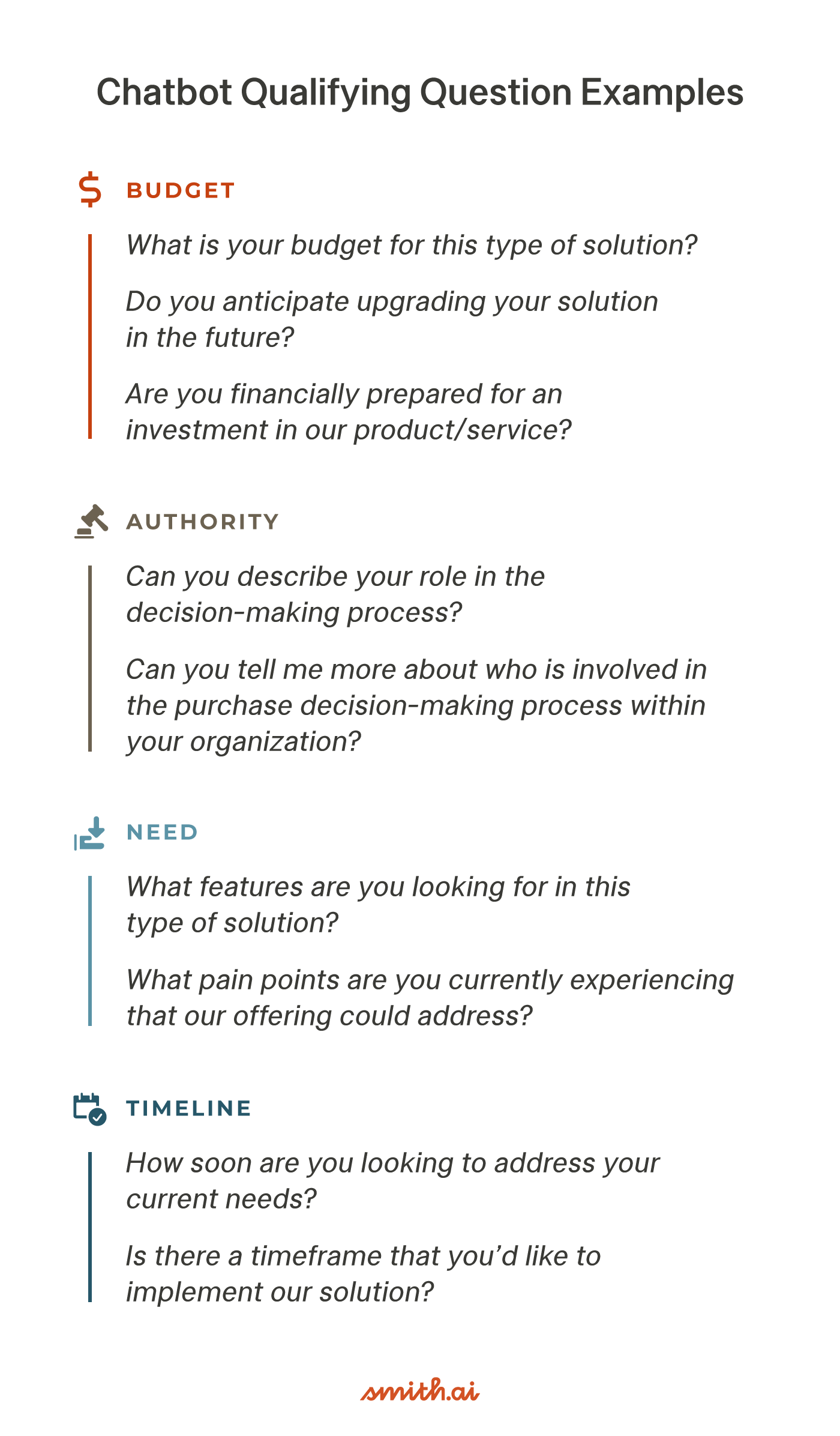How Do Chatbots Qualify Leads + Support Sales Teams?

Quick Answer
Every salesperson knows the pain of wasting time on a lead that doesn’t result in a sale. Chatbots help streamline the lead qualification process, making it more effective — and profitable. In fact, data shows that over 60% of businesses with chatbots use them to qualify leads.
So, how exactly do chatbots qualify leads? Below, we’ll break down what a lead qualification bot is, how it qualifies leads, and how you can use a chatbot to streamline your own lead qualification process.
What is lead qualification?
Lead qualification identifies and prioritizes potential customers who are a good fit for your products or services.
Without chatbots, sales teams have to manually review and qualify each lead — gathering information and engaging in conversations during initial sales calls (sometimes called discovery calls) to uncover potential pain points and determine the likelihood of lead conversion.
Not only is this a time-intensive process, but it is also prone to human error, such as incorrect data recording. In addition, manually qualifying leads hinders the ability to scale because it isn’t always possible for salespeople or agents to effectively manage a high volume of leads simultaneously. These bottlenecks could ultimately lead to missed opportunities and revenue.
What is a lead qualification bot?

A lead qualification bot is an AI-powered web chat tool that can help qualify potential leads or customers. It uses predetermined criteria and questions that you set in place to collect data on your leads and potentially even classify them based on their likelihood of making a purchase or utilizing your services.
Chatbots can ultimately speed up lead qualification and improve how leads are assessed. This ensures your sales team devotes more time to leads more likely to convert into paying customers. As your company scales and generates more leads, chatbots can help you qualify a larger volume of prospects without causing bottlenecks in the sales process.
How do chatbots qualify leads?
Chatbots qualify leads by asking strategic questions written by a human sales team, gathering essential prospect information via natural conversation, and streamlining the process of vetting leads for sales teams.
Here’s a step-by-step process of how lead qualification bots work:
- Engage in conversation: The chatbot initiates the conversation or responds to inquiries from website visitors.
- Ask predefined questions: The chatbot gathers important information about a lead, like their contact details, budget, and needs, using predefined questions that guide the conversation.
- Validate the response: The chatbot validates a lead’s response for consistency and accuracy, flagging any response that needs more clarification or review from human agents.
- Analyze the response: The chatbot then analyzes the data it collected using natural language processing to understand the meaning behind the lead's response.
- Evaluate the lead: Based on the responses, some chatbots can assign a score indicating the level of interest or qualification and categorize the lead based on that score, while others provide sales teams with the information they need to do the scoring and categorization themselves.
- Store data: The chatbot will record and store the data in your database so human agents can reach out to qualified leads.
How to use a chatbot for lead qualification: 6 steps
Ready to streamline your lead qualification with the help of a chatbot? Let’s dive into the six steps for setting up a lead qualification bot to support your sales process.
1. Define a qualified lead
First, you want to outline what a qualified lead looks like for your business. Refer to your ideal customer profile (ICP) to determine a potential lead’s pain points, needs, budget, and other key qualification information. You also want to clarify what a lead is not.
Understanding what an ideal customer looks like (or doesn’t look like) will help you design your conversational flow and develop qualifying questions and criteria.
2. Choose the right chatbot software
It’s important to choose a chatbot software that suits your business needs and is compatible with other lead management tools in your tech stack — like your CRM. You may also want to consider a chatbot tool that streamlines different parts of the sales process, like lead nurturing, to assist with conversions.
3. Create qualifying questions

Next, you want to create a list of qualifying questions to help your chatbot gather essential information on a lead to determine whether or not they’re qualified and suitable for your offerings.
When determining what questions to ask, consider using a lead qualification framework like BANT to create questions that focus on budget, authority, need, and timeline.
Here are some examples of potential questions to ask:
- What is your budget for this type of solution?
- Can you tell me more about who is involved in the purchase decision-making process within your organization?
- What pain points are you currently experiencing that our offering could address?
- How soon are you looking to address your current needs?
These questions will help your chatbot asses a lead’s intent and suitability, allowing your team to focus their efforts on leads with greater potential for conversion.
4. Design a conversational flow
A conversational flow is a guided conversation path a chatbot follows. It allows the chatbot to engage naturally, asking questions and providing responses based on the user’s input. These questions and responses are planned ahead of time to ensure conversations run smoothly and capture the relevant information needed to qualify a lead.
Here’s how to design your chatbot's conversational flow:
- Create a scripted conversation: Create a chatbot script that includes your qualifying questions and other queries that will capture essential lead information. Organize the conversation in a logical sequence and create different paths based on common user responses. Essentially, you’re mimicking a natural conversation.
- Test the conversational flow: Test the conversational flow with a small group of users or current customers to uncover any bugs and gather feedback on how you can improve your chatbot's performance.
- Make necessary adjustments: Once you’ve tested it, make any necessary changes and repeat the testing process until you’ve designed a seamless flow that effectively guides conversations through qualification.
At Smith.ai, we make it easy to design a conversational flow for your chatbot. Using our Q&A features, you can create curated answers to your most frequently asked questions, providing users with consistent answers every time. Additionally, you can create playbooks — step-by-step multiple-choice sequences that guide users down a specific pre-built path to gather and capture essential qualifying information.

5. Integrate with other lead management tools
Next, integrate your chatbot with other lead management tools your team uses. This will help create a seamless workflow that enhances your lead management process and moves leads further down the sales funnel. Consider integrating your chatbot with your CRM, marketing automation tools, email marketing software, and analytics and reporting tools.
6. Establish lead scoring criteria
Some chatbots come with their own scoring systems, but you can also leverage your CRM’s lead scoring capabilities. Lead scoring further narrows down your pool of leads, helping identify which prospects are worth pursuing.
It can also be helpful for ongoing lead nurturing — pinpointing a prospect’s position in their buying journey and informing your team of effective strategies that can guide leads closer to making a purchase.
Based on the information your chatbot collects, each lead is assigned a score. You can create a lead scoring model that works for your business, but typically, a higher score indicates a higher chance of conversion.
For example, a lead with a strong need, high budget, and short timeline might receive a high score, while a lead that is shopping around for different solutions and doesn’t need to make a decision for 6 months would receive a lower score.
Your team can then categorize and prioritize leads based on the score they received and other predefined criteria, like budget or purchase intent.
Benefits of chatbots for sales teams
One of the biggest challenges businesses face is the need for more resources to carry out high-powered sales campaigns. You can effectively fill this gap by deploying chatbot technology.
Aside from lead qualification, here are a few other reasons why utilizing chatbots can make your sales process more effective and efficient:
- Lead nurturing: Chatbots can provide leads with valuable content and information, keeping them engaged and moving them further down the sales funnel.
- Lead routing: They can also route leads to the appropriate sales or marketing team for further nurturing or conversion efforts.
- Immediate responses: Chatbots can provide immediate around-the-clock assistance, ensuring no potential lead goes unattended or unnoticed.
- Cost savings: These tools can keep labor and operational costs low by automating routine sales tasks like answering frequently asked questions and gathering basic prospect information.
- Lead data collection: Chatbots can gather key information on leads, like their budget and preferences, helping sales teams tailor their sales strategies to meet prospects' unique needs.
- Higher-quality leads: They use predetermined criteria and qualifying questions to sift through leads that might not be a good fit, allowing agents to focus their efforts on higher-quality leads more likely to convert.
Streamline your lead qualification process with Smith.ai
Chatbots are revolutionizing the lead qualification process — improving efficiency and empowering sales teams to focus on leads that will likely convert to customers. As technology continues to evolve, embracing chatbots and other AI technology is essential for businesses wanting to scale.
At Smith.ai, our AI-powered Web Chat can engage in natural conversations with your customers, effectively answer common questions, and gather important information to qualify leads. If assistance is needed, our 24/7 live agents are always available to intervene in instances that are more complex, sensitive, or require human involvement.
Ready to utilize chatbot technology for your sales process? Schedule a free consultation with our team today to learn more about using a chatbot for lead qualification and other sales tasks.
Related Posts

















.svg)
